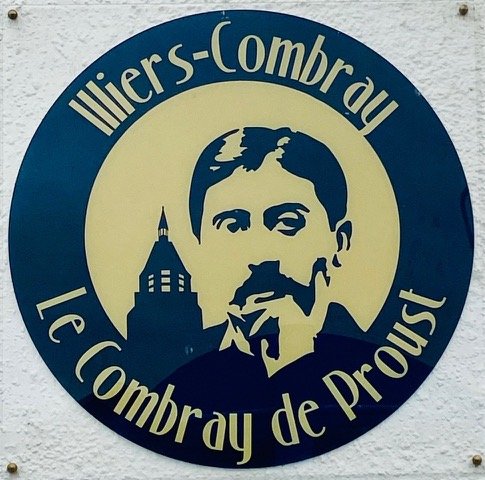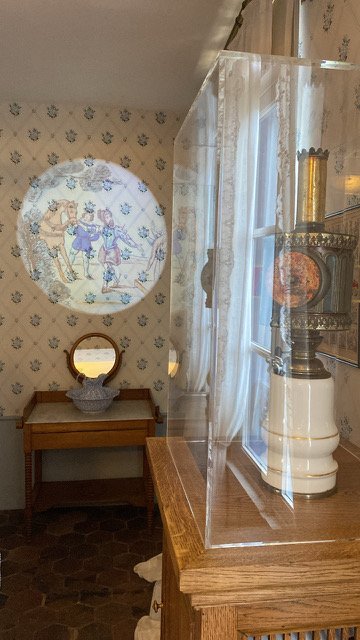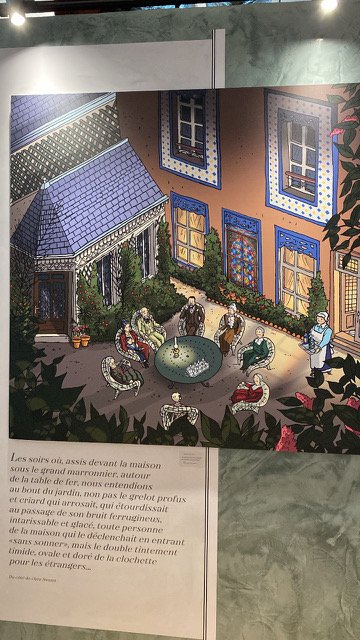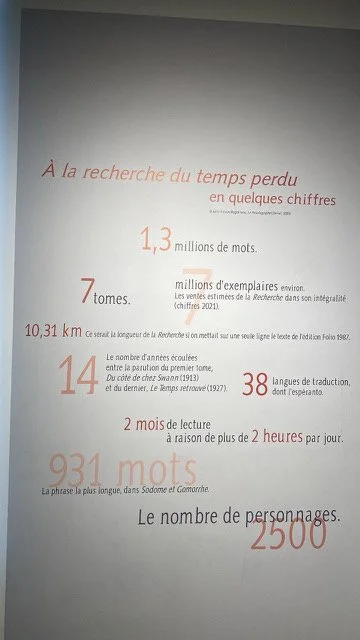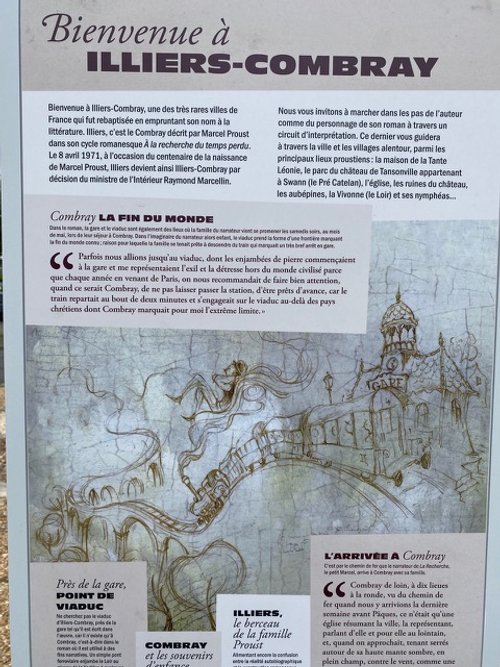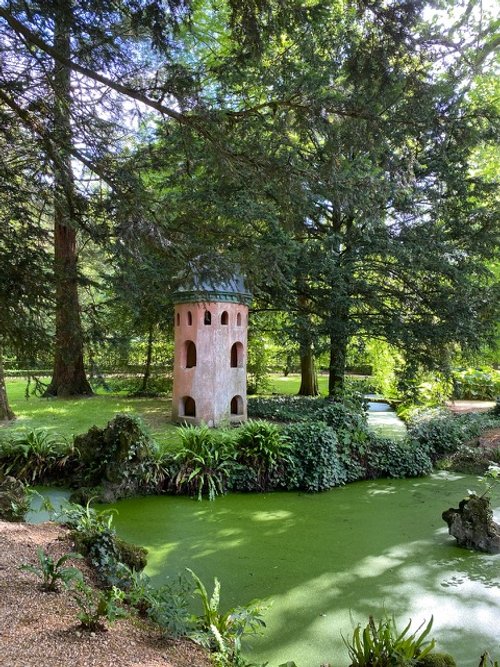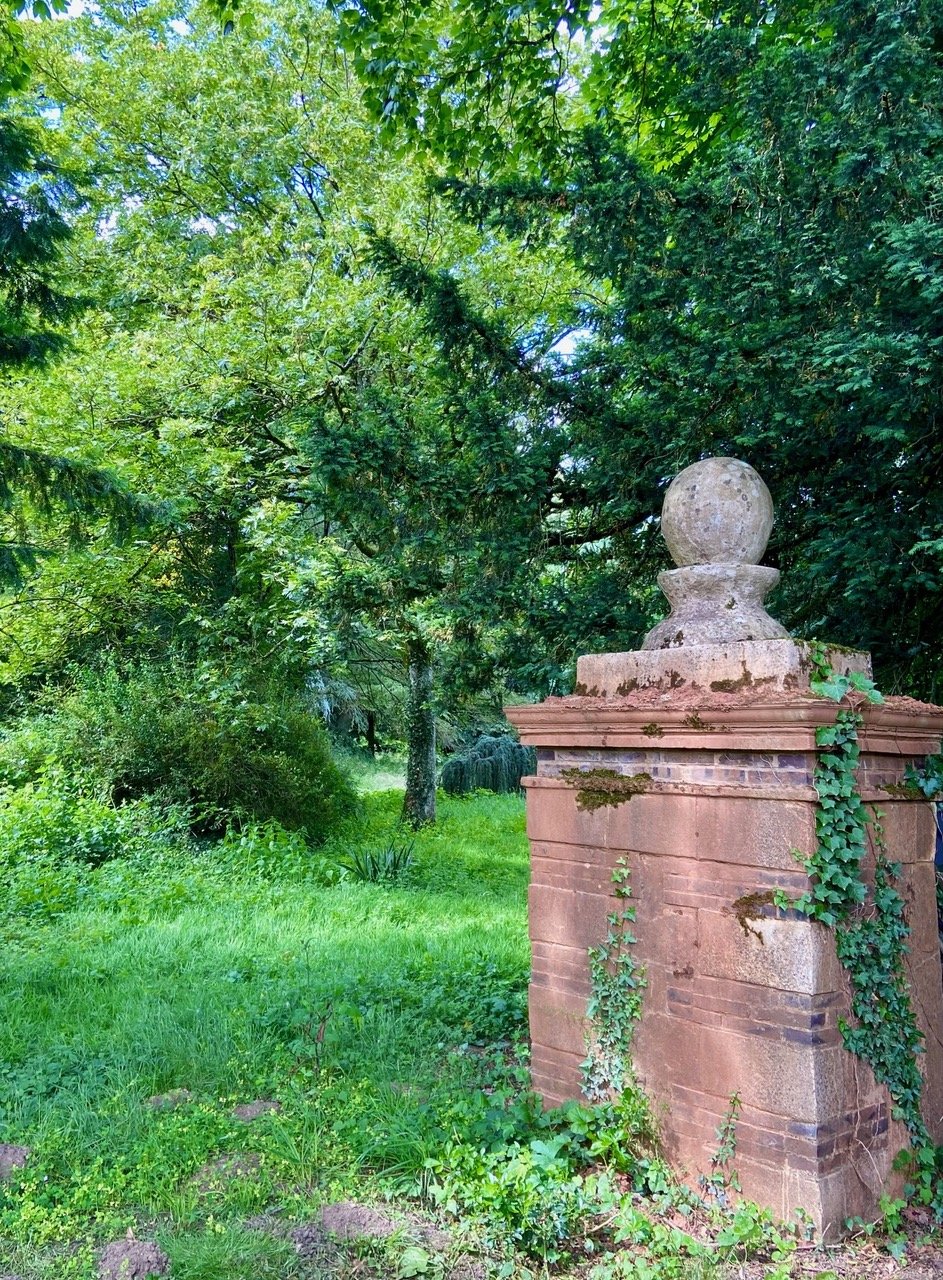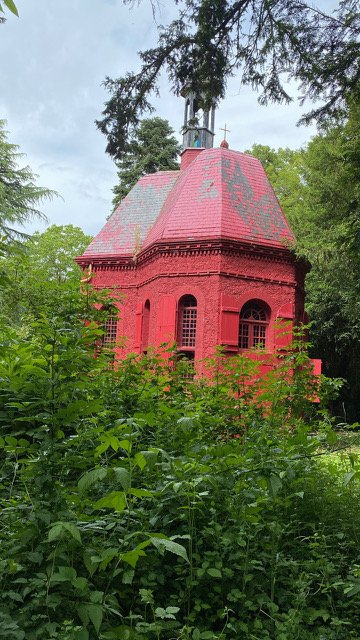Old Things through New Eyes
Newsletter 08.11.2024
“The real voyage of discovery consists not in seeking new landscapes, but in having new eyes”. Marcel Proust.
This week, we’re off to Illiers-Combray! Illiers is the town’s ‘given’ name, Combray is what Marcel Proust called the town in his À la recherche du temps perdu. And Illiers-Combray is what the town officially renamed itself in 1971, to commemorate the centenary of Proust’s birth.
But first, I don’t think I told you about the present Nicolas bought for his girlfriend. He couldn’t decide what to get her. So, he asked her what she wanted. Perfume was the quick answer, because France is known for its perfume. We never considered Bon Marché or Galleries Lafayette or Samaritaine. All of them are too big with too many choices. Guerlain has a lovely boutique just a few blocks from my flat. So that’s were we went the evening before Nicolas left. I plan everything. He plans almost nothing. We both get things done, in our own fashion. The Guerlain boutique is beautiful, although I couldn’t stay inside for long - the fragrances were too overwhelming for a migraine prone girl like me. The sales woman was charming. And patient. Once Nicolas made his choice, she told him that he could have the perfume bottle engraved. So that when it was empty, he could bring it back for a refill. A very classy recycling project! And a nice memory every time I walk along rue Franc Bourgeois (which is often!). (Figs 1, 2) Memory is this week’s topic.
Figure 1. At Guerlain, Nicolas watches the Saleswoman engrave the bottle of perfume he bought
Figure 2. At Guerlain, refrigerator filled with fragrances for decanting
When I made my first Proust pilgrimage, in February, to Cabourg, which Proust calls Balbec, (read about it here)I went and stayed in style. That is, I drove up and stayed at the luxurious Grand Hotel - where Proust stayed.
This time, my trip was more modest but maybe more authentic. I went by train from Paris. It’s easy - you take the RER from Gare Montparnasse to Chartres. That trip takes about an hour. The TER from Chartres to Illiers-Combray arrives about 20 minute after you do. From Chartres to Illiers-Combray is 30 minutes.
I thought about making it a day trip, but when I received a $100 bonus from Airbnb (for being a Superhost!), I decided to stay overnight, once I confirmed that there are Airbnbs in Illiers-Combray. It made seeing and savoring everything I wanted to see and savor so much more relaxing!
As soon as you arrive at the train station in Illiers-Combray, you know that you’re in Proust Country. (Figs 3, 4)
Figure 3. Me in front of train station at Illiers-Combray
Figure 4. This sign was on a wall of the train station
As I made my way from the train station to my Airbnb, which was an easy 15 minute walk, I bumped into an elephant! The circus was in town. (Figs 5, 6) I had my own Proustian moment right there. I remembered being in a small town somewhere in La France Profonde (French countryside). Posters on buildings and trees trunks and lamp posts announced the arrival of the circus. We succumbed to six year old Nicolas’ entreaties, and the four of us went to the circus. Sitting in a hot, dusty tent just outside of town, I was transported back to my own childhood, in a larger city, where three ring circuses were filled simultaneously with high wire acts, horseback riders and clowns.
Figure 5. Walking to my Airbnb, I saw this circus elephant
Figure 6. The circus is in town, well not IN town, but an easy walk from town
My Airbnb was a modest flat in a small apartment building of Airbnb flats. Which would definitely not be tolerated in Paris or San Francisco. Housing shortages and regulations being what they are in both cities. But the flat’s location was ideal for my purposes. Two signs just across from the apartment pointed in opposite directions. To the left, Tante Leonie’s House, where Proust stayed when he was a child. To the right, the Pré Catelan Garden, which Proust transformed into Swann’s garden.
Marcel Proust, as you probably know, grew up in Paris. For three years, starting at age 6, he, his mother, father and younger (by 2 years) brother (Fig 7) traveled to Illiers for Easter and for summer holidays. Because that was where Adrien Proust (Fig 8), Marcel’s father had been born and where most of his family still lived. They stayed with Marcel Proust’s aunt.
Figure 7. Marcel and Robert Proust as boys
Figure 8. Adrien Proust
I read somewhere that if it hadn’t been for his literary son, Adrien Proust would be the famous Proust. He studied medicine and specialized in hygiene (don’t you wish they all did), concentrating on the transmission of contagious diseases. In 1869, the French government sent him to Russia and Persia to determine the route cholera had taken to Russia during the 1832 epidemic. He returned to Paris via Mecca because he wanted to trace how diseases were spread during pilgrimages.
To fight the spread of epidemics, Proust proposed creating, whenever it was needed, a ‘cordon sanitaire,’ which by containment and sequestration would interrupt the spread of disease by transportation, particularly maritime transportation. He urged people to keep their distance from sick people and to wash their hands and face frequently. Which is the protocol he followed on his travels and he never caught the contagious diseases that were killing people all around him. Proust’s proposals mostly fell upon deaf ears (sound familiar?), those of his medical colleagues and those with international mercantile interests. It wasn’t until 1908, 5 years after his death, that an international convention was signed, to provide a coordinated effort to fight against the bubonic plague, yellow fever and cholera. The protocols he wrote were the blueprint that the world finally followed during Covid. (‘In Search of a Lost Father: Adrien Proust, an Almost Forgotten Public Health Pioneer” (2022 Nat’l Library of Medicine) & Simon Schama “How Adrien Proust-Father of Marcel-Helped Pioneer Global Public Health” (Literary Hub 2023).
Okay, back to Illiers. Proust’s family arrived by train from Paris via Chartres, just like I did. They stayed with Proust's aunt, his father's older sister Elisabeth, whose married name was Amiot. Her husband, Jules Amiot, was a merchant who traveled to and traded with Algiers. Which influenced the decorations in his house.
Amiot was a passionate gardener who had two gardens. One was at his home. The other he created on a parcel of land not far from his house. That park also shows an Algerian influence. I’ll show you the Pré-Catelan in a moment.
Proust’s aunt lived her entire life in Illiers, as did her fictional counterpart, Tante Leonie. According to Proust, when Tante Leonie’s husband died, she “never wanted to leave, at first Combray, then..her house, then her room, then her bed (where she was) always lying in an uncertain state of grief, … illness,.. and devotion….” Until she died. With her death, in the book and in ‘real life’ Marcel’s family inherited her cook, Francoise in the book, Ernestine in real life. In real life only, Marcel received a substantial enough inheritance that he never had to earn a living.
Elisabeth Amiot’s house was given to the Amis de Marcel Proust in 1976 by Germaine Amiot, the stepdaughter of “Tante Leonie.” It’s been a museum ever since. (Figs 9, 10)
Figure 9. Me at the entrance of the Maison de Tante Leonie (and Musée Marcel Proust)
Figure 10. Exterior of Maison Tante Léonie
When I visited, the house had just reopened - renovated, remodeled and expanded. It’s now one part historical home, one part art gallery and two parts history museum. Lucas Pialot, writing for Figaro in April 2024, a month before the house reopened wrote this. “The merit of the Marcel Proust Museum-Maison de Tante Léonie… which reopens after two years of work and 4 million euros.., is to make Proust’s existence accessible.” The renovations were guided by Proust’s childhood memories.
The house itself is quite small. On the ground floor, the most evocative room is the tiny tile-floored kitchen, brimming with the tools (including a Madeleine tin, bien sur) that Francoise/ Ernestine used to make the delightful dinners the narrator describes in the first book of A la recherche, Du côté de chez Swann (Swann’s Way). It’s where Francoise tormented the pregnant kitchen maid who was either suffering from morning sickness or was allergic to the asparagus that Francoise made her peel all day long. One side of the kitchen is open to the garden where the narrator saw Francoise/Ernestine break the neck of the chicken the family later ate for dinner. (Fig 11)
Figure 11. Kitchen at Maison Tante Leonie - with asparagus plate (on table) and Madeleine tin (in back)
Figure 11a. Detail of kitchen, Maison Tante Leonie
Upstairs are the bedrooms of Tante Leonie, Marcel’s mother and Marcel. In Tante Leonie’s bedroom is a table with a statue of the Madonna, a bottle of Vichy water and a box of pastilles. Also a teacup, a tea pot, and a handful of tilleul/linden flowers, stems and leaves. Also a madeleine. (Figs 12 - 14) We are, as they sang in the musical Hamilton, “in the room where it happened.” The room in which Aunt Leonie “dipped a small Madeleine into the boiling infusion of which she savored the taste of dead leaves or faded flowers, a piece of which she handed me when it was sufficiently softened.”
Figure 12. The model for Tante Leonie, Marcel’s real aunt, Elisabeth Amiot
Figure 13. The bedroom of Tante Leonie
Figure 14. Detail of side table tea cup (filled with tilleul leaves & stems) & Madeleine & my blue shoes
Walking around Illiers-Combray the two days I was there, I happened upon quite a number of boulangeries selling ‘authentic’ madeleines. The few I tried were dry and really needed a dip (maybe a drenching) in a cup of tilleul/linden tea. (Fig 15)
Figure 15. Boulangerie with Proust Madeleines
In Marcel's bedroom, the room Proust actually slept in as a child, there is a side table with a magic lantern on it. When he couldn’t sleep, young Marcel amused himself by watching images projected on the bedroom’s white wall. It was from the window overlooking the garden that the little boy narrator called to his mother, who was in the garden entertaining friends, and asked her for his bedtime kiss. (Figs 16-18)
Figure 16. Magic Lantern in Proust’s bedroom
Figure 17. One of scenes projected on wall from the magic lantern in Proust’s bedroom
Figure 18. What Proust saw from his bedroom window - his parents entertaining guests
In the art gallery there are paintings and sketches and drawings by and of Proust’s friends, many of whom were models for the people who populated his books. Paintings by Jacques-Émile Blanche are here. He’s the artist who painted the most famous portrait of Proust - the one with a white orchid in his buttonhole. (Fig 18) Two paintings from the Musée d’Orsay are here, by Paul-César Helleu, one of Proust’s inspirations for the artist Elstir. (Fig 19) And one by Rene-Xavier Prinet of Cabourg (Fig 20)
Figure 18. Marcel Proust, Jacques-Émile Blanche
Figure 19, Three Women in a Park, Paul-César Helleu
Figure 20. The Beach, Cabourg, René-Xavier Prinet
The historical museum itself is really an interpretive center with everything you want to know, no matter how you might want to know it - pictures, statistics, synopses - in short everything, except maybe how to get through the books themselves. (Figs 21-25)
Figure 21. By the numbers - some basic numbers regarding Proust’s masterpiece
Figure 22. How the Madeleine came to be the star (or at least the first) in Proust’s first book
Figure 23. Part of the Proust timeline, book 1
Figure 24. Proust wasn’t a stay in bed kind of guy all his life, here are the destinations of his many travels
Figure 25. Informational Panels like this one are everywhere in Illiers-Combray
There is a bookshop and it is a Proustian’s dream. I bought Volumes 6 & 7 of A la recherche in French and some Proust ‘stuff’ too.
Tante Leonie’s house wasn’t the only place I visited. I explored other significant structures in town, too. I started at the church. Which in real life, is Saint Jacques. Proust calls it Saint-Hilaire. He was fascinated by the Church’s stained glass windows, only one of which remains from his childhood, Christ between Saint Hilaire and Saint Jacques. Inside the very long church, with its beautifully painted vault, are scallop shell decorations. (Figs 26 - 29) These are the ‘Coquilles de Saint-Jacques’ worn by pilgrims walking the Camino. They are, of course also the shape of the Madeleines that got Proust started.
Figure 26. St. Jacques, Illiers-Combray, the church Proust calls St. Hilaire
Figure 27. Grand interior of St. Jacques
Figure 28. Coquille de Saint Jacques, second row from bottom, third image over
Figure 29. Two symbols of the Chemin de Saint Jacques, one a stylized coquille, the other a pilgrim walking to Santiago de Compostela.
Then I visited the Pré-Catelan garden, created by Proust’s uncle by marriage, Jules Amiot. When Proust wrote about it, he called it the Jardin de Tansonville. It is where the narrator first meets Gilberte, Charles Swann’s daughter, his first true love.
The Pré Catalan, which is now also called the Jardin Marcel Proust was Jules Amiot’s pleasure garden. The name is a tribute to the Pré Catelan garden in the Bois de Boulogne. The design is a tribute to the Buttes-Chaumont. Both are well known and well visited Paris parks. Although this Pré Catelan is much smaller than the one in Paris, for a town the size of Illiers, it’s pretty big. There are rows of linden (tilleul) trees (for his wife’s infusions?), huge chestnuts and a small and meandering tributary of the Loir River, which Proust calls the Vivonne River. And there are follies (decorative buildings). Among which is a kouba (oriental mortuary monument) and “Arab” dovecotes, a references to Amiot’s fascination with the architecture of Algeria. (Figs 30-34)
Figure 30. Entrance to the Pré Catelan, aka Jardin Marcel Proust
Figure 31. Pré Catelan
Figure 32. Pré Catelan double grotto
Figure 33. Mill in Pré Catelan, sort of a miniature golf vibe
Figure 34. Another Pré Catelan folly
The final place I visited was the Chateau de Swann. Although the sign in front said it was open, the iron gate was locked tight. Undeterred, I rang the doorbell and a young Asian man came to the gate and let me in. Unlike Tante Leonie’s home, the Amis de Proust doesn’t own this property. The Chinese writer Ya Ding bought the Château de la Sinetterie and opened it to the public under the name Château de Swann. Its connection with Proust are well documented. The chateau was owned by a friend of Andrien Proust, Marcel’s father and Marcel probably played there as a child. It may be the chateau he recalled when he wrote about Tansonville, the chateau just outside Combray, Charles Swann's chateau. The new owner has decorated it with 19th furniture as well as paintings, documents and photographs celebrating the fictionaly Charles Swann and his wife, the former courtesan, Odette. (Figs 35-38)
Figure 35. Chateau de Swann, just outside of Illiers-Combray
Figure 36. The Salon, Chateau of Swann
Figure 37. Charles Swann’s bedroom
Figure 38. Odette’s Bedroom, Chateau de Swann
The chateau’s website urges you to take time to stroll through the chateau’s 3 hectare garden. But it’s mostly overgrown and not particularly conducive to a casual stroll. There is a folly here. Or maybe it was a chapel. Anyhow, the new owner has painted it blood red. (Figs 39-41) According to Ding, it’s meant to be a human heart, which he sees as the symbol of Marcel Proust's sensitivity. I am going to have to do some research and find out what the Amis de Marcel Proust think of this private effort to capitalize on a place’s association with Proust. I had fun poking around both inside and outside. It certainly wasn’t anywhere near as dry as most of the Madeleines I tried in Illiers-Combray! This is a town that can easily be a day trip from Paris but what the heck, go overnight and spend some time in Chartres exploring the Cathedral either before or after your trip to Proust country. Gros bisous, Dr. B. Thanks for your Comments, they are much, much appreciated.
Figure 39. Garden at Chateau de Swann
Figure 40. Folly or Chapel in garden at Chateau de Swann
Figure 41. The Chapel interior, Chateau de Swann
New comment on Man’s (original) Best Friend:
Thank you once again for your most recent two posts. The horse oriented entry combined my two greatest loves, horses and art.. I found the exhibit will be on display through November so I am very excited that I might get to see it. We are hoping to visit in October with a stop in Deauville for horse sales and to visit our own horses that live on a farm nearby. I would have never been aware of the exhibit at Versailles if not for your post.
New Comments on The Show Must Go On ….. And It Did!!!:
1.
Fantastic review. We watched far more of this than expected... Jeanne said simply... "Only the French could do this." We have been away from Paris for too long. Bob
2.
We watched the opening ceremony as presented by the BBC channels. It was good, but Beverly's post added a lot of info that I didn't get on the channel. If I had watched a French channel, I would probably have gotten more background on what I was watching.
For example, I thought Lady Gaga's performance and choreography were very ugly, but Beverly's explanation of the deal with the feathers would have helped. Also, we didn't see as much of what was going on at the Conciergerie as she talks about.
She also explained the faces that were submerged in the Seine, which I loved but didn't connect them to the references she points out to the original paintings, and the BBC show didn't really focus on them at all. Peg, London
3.
I love reading your blog, and have also passed it along to my niece, who teaches Middle Eastern history, religion and culture at Denver U. We were there both weekends of the French vote, and I was able to have fascinating conversations with individuals and learn more about the French voting system, especially the proxy system.
What I love about your blog is that you cover a little bit of everything. I minored in Art History and find that of all my studies, it has been the most relevant as we lived in various parts of the world and now, as we travel. But it's all context, isn't it? I appreciate that you include so much context as you write, food, culture, happenings, it all helps give a bigger picture. Thank you. Pat
4.
(L)oved you characteristic comprehensive explanations of the Opening Ceremonies of the Olympics. I was glued to the TV for the event. It was truly spectacular though I am not sure how I felt about the pre taped portions as I thought the spectators should able to view all(maybe there were video screens for those present?) Also that part seemed a bit disjointed but your post clarified it and cured my confusion. Overall it was a wildly successful effort by France to welcome the world to the Olympics. Thanks for your coverage!
Copyright © 2024 Beverly Held, Ph.D. All rights reserved
Dear Reader, I hope you enjoyed reading this article. Please sign up below to receive more articles plus other original content from me, Dr. B. Merci!
And, if you enjoyed reading this review, please consider writing a comment. Thank you!




